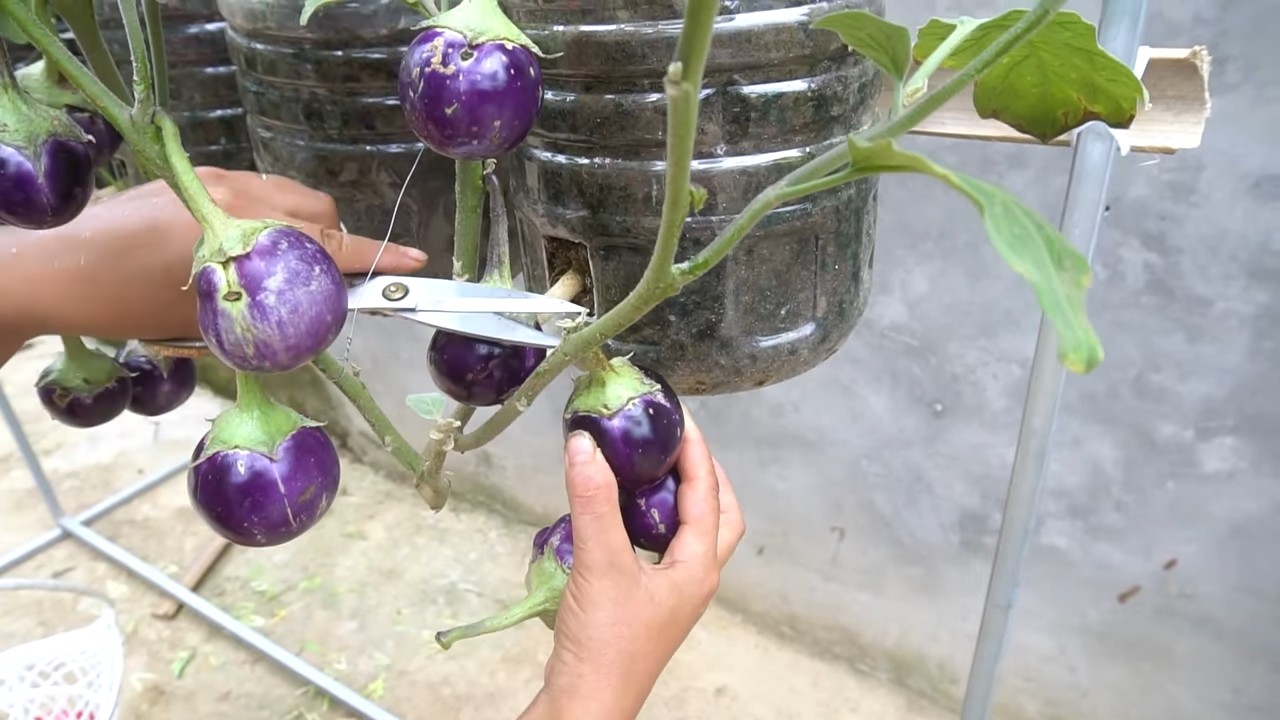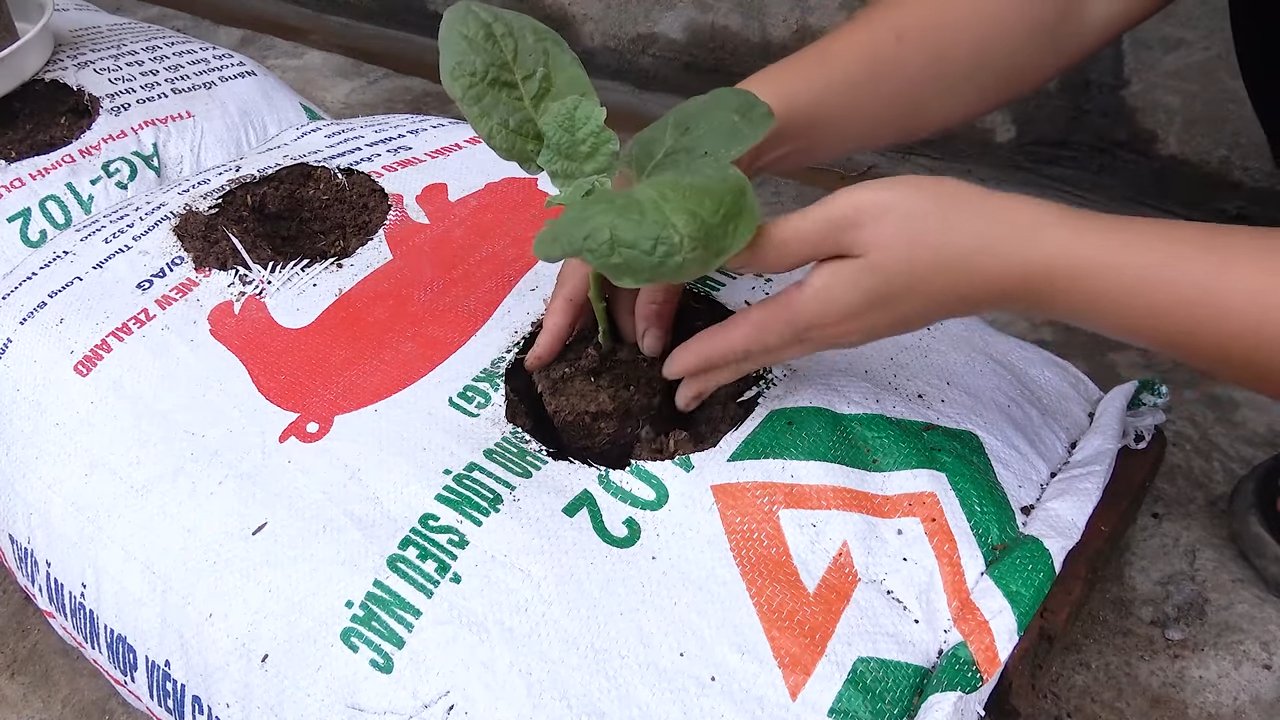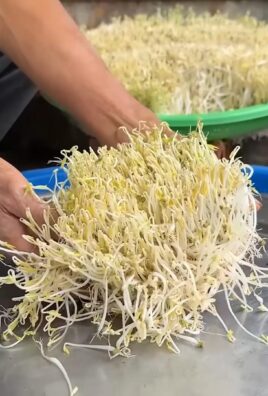Easy way to grow eggplant? Absolutely! I’m so excited to share some simple, yet effective, DIY tricks that will have you harvesting beautiful, plump eggplants from your very own garden. Forget struggling with finicky seedlings and disappointing yields. This article is packed with insider secrets to transform even the most novice gardener into an eggplant-growing pro.
Eggplant, with its glossy skin and rich flavor, has a fascinating history. Originating in India, it’s been cultivated for thousands of years and holds a special place in many cuisines around the world. From the Mediterranean’s moussaka to Asia’s stir-fries, this versatile vegetable is a culinary staple. But growing your own? That’s where the real magic happens!
Let’s face it, store-bought eggplants can be expensive and often lack the vibrant taste of homegrown produce. Plus, there’s nothing quite like the satisfaction of nurturing a plant from seed to table. Many people struggle with growing eggplant because they don’t know the right techniques. They face issues like pest infestations, poor fruit set, and stunted growth. That’s why I’ve compiled these easy-to-follow DIY hacks. I’ll show you an easy way to grow eggplant, ensuring a bountiful harvest and delicious meals all season long. Get ready to roll up your sleeves and discover the joy of homegrown goodness!

Auberginen Anbauen: Dein Einfacher DIY-Leitfaden für eine Reiche Ernte
Hey Gartenfreunde! Auberginen, diese glänzenden, violetten Schönheiten, sind nicht nur lecker, sondern auch eine tolle Ergänzung für jeden Gemüsegarten. Viele denken, sie seien schwierig anzubauen, aber ich zeige dir, dass es gar nicht so kompliziert ist. Mit ein paar Tricks und Kniffen kannst auch du eine reiche Auberginenernte erzielen. Los geht’s!
Die Vorbereitung: Der Schlüssel zum Erfolg
Bevor wir mit dem eigentlichen Anbau beginnen, ist eine gute Vorbereitung das A und O. Hier sind die wichtigsten Punkte, die du beachten solltest:
* Die richtige Sorte wählen: Es gibt unzählige Auberginensorten, von den klassischen violetten bis hin zu weißen, grünen oder sogar gestreiften. Informiere dich, welche Sorten in deiner Region gut gedeihen und welche dir am besten schmecken. Beliebte Sorten sind ‘Black Beauty’, ‘Violetta Lunga’ und ‘Listada de Gandia’.
* Der perfekte Standort: Auberginen lieben die Sonne! Wähle einen Standort, der mindestens 6-8 Stunden direkte Sonneneinstrahlung pro Tag erhält. Außerdem sollte der Boden gut durchlässig und nährstoffreich sein.
* Die Bodenbeschaffenheit optimieren: Auberginen sind Starkzehrer, das heißt, sie benötigen viele Nährstoffe. Verbessere den Boden mit Kompost, gut verrottetem Mist oder einem organischen Dünger. Ein leicht saurer pH-Wert (zwischen 6,0 und 6,8) ist ideal.
* Vorkultur oder Direktsaat?: In den meisten Regionen ist es ratsam, Auberginen vorzuziehen, da sie eine lange Wachstumsperiode haben. Die Direktsaat ist nur in sehr warmen Klimazonen möglich.
Auberginen Vorziehen: Schritt für Schritt
Das Vorziehen von Auberginen ist einfacher als du denkst. Ich zeige dir, wie es geht:
1. Der richtige Zeitpunkt: Beginne mit der Vorkultur etwa 6-8 Wochen vor dem letzten erwarteten Frost. In Deutschland ist das meistens im März oder April.
2. Das passende Saatgut: Kaufe hochwertiges Saatgut von einem vertrauenswürdigen Anbieter. Achte auf das Mindesthaltbarkeitsdatum.
3. Die Aussaat: Fülle kleine Anzuchttöpfe oder eine Anzuchtschale mit Anzuchterde. Drücke die Erde leicht an und säe die Samen etwa 0,5-1 cm tief. Bedecke die Samen mit Erde und gieße sie vorsichtig an.
4. Die richtige Umgebung: Stelle die Anzuchttöpfe an einen warmen, hellen Ort. Eine Temperatur von 22-25°C ist ideal für die Keimung. Du kannst auch ein Mini-Gewächshaus oder eine Heizmatte verwenden, um die Temperatur zu erhöhen.
5. Feuchtigkeit bewahren: Halte die Erde feucht, aber nicht nass. Besprühe die Erde regelmäßig mit einer Sprühflasche. Vermeide Staunässe, da dies zu Fäulnis führen kann.
6. Die Keimung: Die Keimung dauert in der Regel 1-2 Wochen. Sobald die ersten Keimlinge erscheinen, stelle die Anzuchttöpfe an einen noch helleren Ort.
7. Pikieren: Wenn die Sämlinge 2-3 echte Blätter haben, ist es Zeit zum Pikieren. Das bedeutet, dass du die Sämlinge in größere Töpfe umpflanzt. Fülle die neuen Töpfe mit Gemüseerde und setze die Sämlinge vorsichtig ein. Achte darauf, die Wurzeln nicht zu beschädigen.
8. Abhärten: Bevor du die Auberginen ins Freie pflanzt, musst du sie abhärten. Das bedeutet, dass du sie langsam an die Bedingungen im Freien gewöhnst. Stelle die Pflanzen tagsüber für ein paar Stunden ins Freie und hole sie abends wieder herein. Steigere die Zeit im Freien jeden Tag, bis die Pflanzen den ganzen Tag draußen bleiben können.
Auberginen Auspflanzen: Der Umzug ins Freie
Nachdem du deine Auberginen vorgezogen und abgehärtet hast, ist es Zeit, sie ins Freie zu pflanzen. Hier sind die wichtigsten Schritte:
1. Der richtige Zeitpunkt: Pflanze die Auberginen erst aus, wenn keine Frostgefahr mehr besteht. In Deutschland ist das meistens Mitte Mai, nach den Eisheiligen.
2. Die Pflanzvorbereitung: Grabe Pflanzlöcher, die etwas größer sind als die Wurzelballen der Auberginen. Der Abstand zwischen den Pflanzen sollte etwa 45-60 cm betragen.
3. Das Einpflanzen: Setze die Auberginen vorsichtig in die Pflanzlöcher und fülle sie mit Erde auf. Drücke die Erde leicht an und gieße die Pflanzen gründlich an.
4. Stützen: Auberginenpflanzen können recht groß und schwer werden. Es ist daher ratsam, sie mit Stäben oder einem Rankgitter zu stützen.
5. Mulchen: Bedecke den Boden um die Auberginen mit Mulch. Mulch hilft, die Feuchtigkeit im Boden zu halten, Unkraut zu unterdrücken und den Boden zu düngen. Du kannst Stroh, Holzhackschnitzel oder Rasenschnitt als Mulch verwenden.
Die Pflege: Damit deine Auberginen prächtig gedeihen
Die richtige Pflege ist entscheidend für eine reiche Auberginenernte. Hier sind die wichtigsten Punkte, die du beachten solltest:
* Gießen: Auberginen benötigen regelmäßig Wasser, besonders während der Blütezeit und der Fruchtbildung. Gieße die Pflanzen am besten morgens, damit die Blätter bis zum Abend abtrocknen können. Vermeide Staunässe.
* Düngen: Dünge die Auberginen regelmäßig mit einem organischen Dünger oder einem speziellen Auberginendünger. Beginne mit dem Düngen etwa 2-3 Wochen nach dem Auspflanzen.
* Ausgeizen: Auberginen bilden viele Seitentriebe. Um die Fruchtbildung zu fördern, kannst du die Seitentriebe ausgeizen. Entferne die Triebe, die zwischen dem Hauptstamm und den Blättern wachsen.
* Schädlinge und Krankheiten: Auberginen können von verschiedenen Schädlingen und Krankheiten befallen werden, wie z.B. Blattläusen, Kartoffelkäfern, Mehltau oder Grauschimmel. Kontrolliere die Pflanzen regelmäßig und bekämpfe Schädlinge und Krankheiten frühzeitig mit geeigneten Mitteln. Ich bevorzuge natürliche Methoden wie Neemöl oder Schmierseifenlösung.
* Bestäubung: Auberginen sind selbstbefruchtend, aber die Bestäubung kann durch Wind oder Insekten verbessert werden. Du kannst die Blüten auch von Hand bestäuben, indem du mit einem Pinsel von Blüte zu Blüte gehst.
Die Ernte: Der Lohn deiner Mühe
Die Erntezeit ist der Höhepunkt der Auberginenanbaus. Hier sind die wichtigsten Punkte, die du beachten solltest:
1. Der richtige Zeitpunkt: Auberginen sind reif, wenn sie eine glänzende, pralle Haut haben und sich leicht eindrücken lassen. Die Farbe sollte intensiv sein.
2. Die Erntetechnik: Schneide die Auberginen mit einem scharfen Messer oder einer Gartenschere ab. Lasse einen kleinen Stiel an der Frucht.
3. Die Lagerung: Auberginen sind nicht lange haltbar. Lagere sie im Kühlschrank, wo sie etwa eine Woche haltbar sind. Du kannst Auberginen auch einfrieren oder einlegen.
Zusätzliche Tipps für eine erfolgreiche Auberginenernte
* Fruchtfolge beachten: Pflanze Auberginen nicht jedes Jahr am selben Standort. Wechsle den Standort, um Krankheiten und Schädlingen vorzubeugen.
* Begleitpflanzung: Pflanze Auberginen zusammen mit anderen Pflanzen, die sich gegenseitig unterstützen. Gute Begleitpflanzen sind Basilikum, Ringelblumen oder Knoblauch.
* Regelmäßig kontrollieren: Kontrolliere deine Auberginenpflanzen regelmäßig auf Schädlinge und Krankheiten. Je früher du Probleme erkennst, desto einfacher ist es, sie zu beheben.
* Nicht aufgeben: Manchmal läuft nicht alles nach Plan. Lass dich nicht entmutigen, wenn du nicht sofort eine reiche Ernte erzielst. Lerne

Conclusion
So, there you have it! Growing your own eggplants doesn’t have to be a daunting task. By implementing this simple yet effective DIY trick, you’re not just planting seeds; you’re cultivating a thriving garden and ensuring a bountiful harvest of delicious, homegrown eggplants. This method, focusing on [mention the specific DIY trick from the main article, e.g., “seed starting in egg cartons” or “companion planting with basil”], offers a significant advantage over traditional methods, providing better germination rates, stronger seedlings, and ultimately, healthier, more productive eggplant plants.
Why is this a must-try? Because it’s accessible, cost-effective, and yields impressive results. Forget about expensive gardening equipment or complicated techniques. This DIY approach empowers even novice gardeners to experience the joy of growing their own food. Imagine the satisfaction of serving a meal featuring eggplants you nurtured from tiny seeds to plump, vibrant vegetables.
But the journey doesn’t end here! Feel free to experiment with variations to tailor this technique to your specific needs and environment. For instance, if you live in a particularly hot climate, consider providing extra shade during the hottest part of the day. Or, if you’re short on space, explore container gardening options using larger pots and dwarf eggplant varieties. You could also try different companion plants alongside your eggplants, such as marigolds to deter pests or beans to fix nitrogen in the soil.
Don’t be afraid to get creative and personalize this DIY eggplant growing method to suit your unique gardening style. The possibilities are endless!
We wholeheartedly encourage you to give this DIY trick a try. It’s a game-changer for anyone looking to grow healthy, delicious eggplants at home. And most importantly, we want to hear about your experience! Share your successes, challenges, and any modifications you make along the way. Your insights will not only inspire other gardeners but also contribute to a collective knowledge base that benefits everyone.
So, grab your seeds, gather your supplies, and get ready to embark on an exciting eggplant-growing adventure. Remember, with a little patience, dedication, and this handy DIY trick, you’ll be enjoying a plentiful harvest of homegrown eggplants in no time. Happy gardening! We are confident that this method will help you achieve success in your eggplant cultivation efforts. Remember, the key to successful gardening is observation and adaptation. Pay attention to your plants, adjust your techniques as needed, and most importantly, have fun! Growing your own food is a rewarding experience, and we’re here to support you every step of the way. Let us know how this **easy way to grow eggplant** works for you!
Frequently Asked Questions (FAQ)
What type of eggplant is best suited for this DIY method?
This DIY method is generally suitable for most eggplant varieties. However, consider your local climate and growing season when selecting your seeds. Shorter-season varieties like ‘Black Beauty’ or ‘Ichiban’ are ideal for cooler climates, while longer-season varieties like ‘Italian Long’ or ‘Rosa Bianca’ thrive in warmer regions. Also, consider the size of your growing space. If you’re container gardening, dwarf varieties like ‘Patio Baby’ are a great choice. Ultimately, the best eggplant variety depends on your personal preferences and growing conditions. Research different varieties and choose one that aligns with your needs.
How often should I water my eggplants grown using this method?
Watering frequency depends on several factors, including the weather, soil type, and the size of your plants. Generally, eggplants need consistent moisture, especially during hot weather. Check the soil moisture regularly by sticking your finger about an inch deep into the soil. If it feels dry, it’s time to water. Water deeply and thoroughly, ensuring that the water reaches the roots. Avoid overwatering, as this can lead to root rot. A good rule of thumb is to water deeply every 2-3 days, but adjust as needed based on your specific conditions. Mulching around the plants can also help retain moisture and reduce the need for frequent watering.
What kind of fertilizer should I use for my eggplants?
Eggplants are heavy feeders and benefit from regular fertilization. Start with a balanced fertilizer (e.g., 10-10-10) at planting time. Once the plants start to flower, switch to a fertilizer higher in phosphorus (the middle number) to promote fruit production. You can use either a granular fertilizer or a liquid fertilizer. Granular fertilizers are slow-release and provide a steady supply of nutrients over time. Liquid fertilizers are fast-acting and can be applied more frequently. Organic options like compost tea or fish emulsion are also excellent choices. Follow the instructions on the fertilizer package carefully to avoid over-fertilizing, which can damage your plants.
How do I protect my eggplants from pests and diseases?
Eggplants are susceptible to various pests and diseases, including aphids, flea beetles, spider mites, and fungal diseases like verticillium wilt. Regularly inspect your plants for signs of infestation or disease. Early detection is key to preventing serious problems. For aphids and spider mites, try spraying the plants with a strong stream of water or using insecticidal soap. Flea beetles can be controlled with row covers or diatomaceous earth. To prevent fungal diseases, ensure good air circulation around the plants and avoid overhead watering. If you notice signs of disease, remove the affected leaves or plants immediately. Consider using organic fungicides if necessary. Companion planting with herbs like basil or marigolds can also help deter pests.
Can I grow eggplants in containers using this DIY method?
Yes, absolutely! Container gardening is a great option for growing eggplants, especially if you have limited space. Choose a large container (at least 5 gallons) with good drainage. Use a high-quality potting mix that is well-draining and rich in nutrients. Dwarf eggplant varieties are particularly well-suited for container gardening. Provide the plants with plenty of sunlight (at least 6-8 hours per day) and water them regularly. Container-grown eggplants may need to be fertilized more frequently than those grown in the ground, as nutrients can leach out of the soil more quickly.
How long does it take for eggplants to mature and be ready for harvest?
The time it takes for eggplants to mature depends on the variety and growing conditions. Generally, it takes about 60-80 days from transplanting to harvest. The fruits are typically ready to harvest when they are glossy, firm, and have reached their mature size and color. Gently press the skin of the eggplant. If it springs back slightly, it’s ready to harvest. Use a sharp knife or pruning shears to cut the fruit from the plant, leaving a small stem attached. Harvest eggplants regularly to encourage continued fruit production. Overripe eggplants can become bitter and seedy.
What are some common mistakes to avoid when growing eggplants?
Some common mistakes to avoid when growing eggplants include:
* Starting seeds too late: Start seeds indoors 6-8 weeks before the last expected frost.
* Planting seedlings too early: Wait until the soil has warmed up and the risk of frost has passed before transplanting seedlings outdoors.
* Overwatering or underwatering: Maintain consistent soil moisture, but avoid soggy conditions.
* Not providing enough sunlight: Eggplants need at least 6-8 hours of sunlight per day.
* Not fertilizing regularly: Eggplants are heavy feeders and benefit from regular fertilization.
* Ignoring pests and diseases: Regularly inspect your plants for signs of infestation or disease and take action promptly.
* Harvesting too late: Harvest eggplants when they are glossy, firm, and have reached their mature size and color.
By avoiding these common mistakes, you can increase your chances of success and enjoy a bountiful harvest of homegrown eggplants.




Leave a Comment